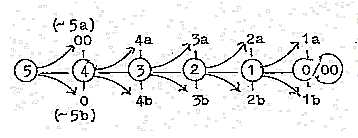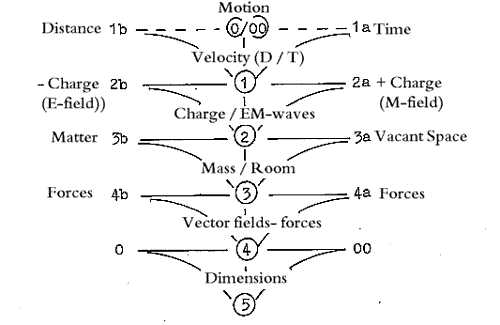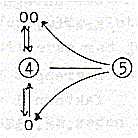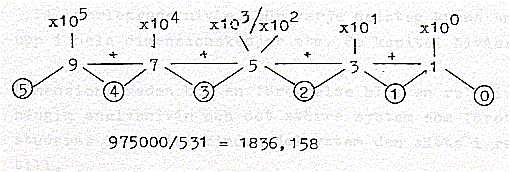1. "Simpleminded" postulates:
- Science seeks tracing manifolds back to unity.
- The creation of universe would presumably have the opposite
direction.
- The most uniform (or integrated) concept we have got is
the Whole (the Entirety).
- The starting
point, therefore, will here be "the Entirety"
as first postulate.
- The simplest way to get manifolds from unity should be
through dividing.
- Assume therefore that the world was created through the
division of the Entirety.
- Science seeks relations.
- In physics some word for relations is often used as equivalent
to the concept of "forces".
- The simplest relation or bond between two parts of a unit
is that they are parts of this unit - or has been. It´s
the relation that reigned "before" the division.
- Assume then that the Entirety is this first bond or relation,
the first force operating between its parts - when it was
divided or split. It may be called the "entirety force".
2. Dimensions as building material:
- Postulated: the entirety and its partition.
- We assume now that the partition has the character of
polarization.
- The concept "dimension" is chosen
as building stone for this model. Geometrically it´s
generally designated by coordinate axis. Dimensions are
usually taken as geometrical concepts.
- It will be stated here that a dimension is characterize
by 2 complementary poles. This means that a dimension is
the result of a partition or split, a polarization.
- Physicists generally have been content with 4 dimensions
(in standard models, 3 for space, 1 for time. ).
Suppose therefore that the Entirety is
one dimension higher, that it is 5-dimensional.
- The 5th dimension degree as the Entirety as first
unit, we now assume, gets polarized in 2 poles, mathematically
designated 0 and 00 (here ∞), a point and the infinity. Geometrically
the poles can be defined as center and "periphery".
Conceptually as center and anticenter = everything else.
Note this new definition of "infinity".
- Suppose further more that every polarization gives birth
to the next lower dimension degree. The polarization then
of the Entirety in center and anticenter gives rise to the
4th dimension degree.
- What you get defined by a polarization center / anticenter
is Direction, outwards/inwards. Compare the vector concept.
The 4th dimension degree ought to be identified and notified
as Direction. (Graphically the 4th dimension degree can
be represented by double arrows, two-ways in direction,
→ ← between center and
anticenter.*
- The 4th dimension degree will in next step be
polarized in outward direction and inward direction. These
are the 2 poles of the 4th dimension degree. This polarization
is assumed to give birth to the 3rd dimension degree, the
definition of volumes geometrically.
- The 3rd dimension degree will be polarized in
the following step in 2 poles. In this first schematic outline,
with a primitive geometry, these 2 poles could be identified
as enclosed and excluded center respectively, or radial
/ circular structure.
- Between the poles of the 3rd dimension degree are surfaces
defined, the 2nd dimension degree geometrically.
- The 2nd dimension degree, that of surfaces, is
in its turn polarized, divided, in 2 poles which possibly
could have the character of inside / outside, convex/concave
surface, or similar identifications geometrically. The polarization
gives the 1st dimension degree, the line.
- The 1st dimension degree, the line, polarized,
gives 2 poles, which we here presume can be identified as
motions: "movements toward each other" and "movements
from each other". (In simple geometry a divided line
leads to the point.)
- Movements towards each other, converging, defines in
their turn a center, a zero- or 0-pole. And movements from
each other, diverging, define an anticenter, a 00-pole.
- With that the 1st dimension degree can be seen to define
the dimension degree of "0/00". These are also
by definition the both poles of the first 5-dimensional
Entirety. Still not the same unpolarized Entirety as at
the beginning.
- The "dimension degree 0/00" - corresponding
to the concept of pure kinetic energy - can be designated
5´ and be supposed to make the starting point for
a new dimensional evolution. (About level development here.)
Motions as concept gets its own place in the scheme and
can be seen as the ultimate translation of the 5th dimension
degree, expressions for the underlying unity.
One can call a development like the here described from
a 5-dimensional unity via dimension degrees 4-3-2-1 to 0/00
for a "dimension chain"
Each dimension degree that is "lost" in the steps
towards lower degrees in the chain is assumed translated
in an external 1-dimensional relation, which can be polarized
in movements.
Essential to note:
All poles, each pair in the chain of dimension degrees,
will be of a complementary type according to the assumptions,
as a result of the first complementarity between center
and anticenter..
*About counting with 5 dimensions, one should
observe that the ordinary mathematical concept of dimensions
presupposes, without mentioning it, a center, an origin
- and plus and minus signs on the opposite directed coordinate
axes: this means a couple of extra specifications in addition
to the 3 about x-y-z coordinates.

First critical
comments:
Main opposition, at first, concerns
probably the geometrical statements about transformations
in d-degree steps 4→3→2→1,
not easy to visualize if at all possible:
1. How does antiparallel vectors (outwards - inwards) in
step 4→3, change to perpendicular
ones? What makes expansion-contraction transform to rotational
phenomena? It's an obvious reality for celestial bodies
in macrocosm and in microcosm, but why and how? Step 4→3.(Later
discussion here.)
2. How justify a statement - in pure geometrical terms,
that in d-degree step 3→2
a polarization between radial and circular geometries in
volumes are defining surfaces or 2-dimensional structures?
Step 3 → 2.
3. And in step 2→1: How
do surfaces - geometrically seen, get polarized into 2 "poles"
which define between them a path line connection or one-dimensional
potentials ? Step 2 → 1.
4. Finally, in the last step from d-degree 1 to motions:
can all motions be interpreted - at bottom - as a pole exchange
between "to and fro", as in waves, as in living
beings? What about rotation - of stars and planets for example?
Other questions:
-What kind of dimension concept do these statements imply?
- What drives the polarizations?
- Where do we find expressions for the unpolarized 4th or
3rd or 2nd dimension degree? Compare about superpositions
in Quantum Physics.
Leaving these and more critical comments for a moment and
further discussions to other pages, we will first suggest
how the model could be applied to more physical concepts,
surely easier to accept:
Elementary quantities or concepts
of physics:
A first connection of this dimension model to the elementary
concepts of physics could be done like this:
5th degree:
As the primary Entirety it doesn’t get any attributes
apart from mathematical. It is the world, everything and
nothing, the whole cosmos, the universe, everything inside
and outside of something or equivalent with universe. (See
note below.)
4th degree:
Here defined as Direction, could be identified with "fields"
in physics, with 4-dimensional vector fields (inwards -
outwards) or pair of forces, in relation to mass ("substance")
when this is studied as such.
3rd degree:
This could be identified with the concepts of Matter and
Space, where matter is analyzed and regarded as simple structure.
Its poles, geometrically defined as characterized by enclosed
/ excluded center, or radial/circular (closed) structure,
could at least out of one aspect be identified with matter/vacant
space.
2nd degree:
Geometrically the dimension of surfaces, the 2nd degree
is already so specified that it should have several expressions.
Here is supposed that this degree could be in some meaning
identified with the physical concept Charge (which the physicists
when this was written didn't know what it was, according
to David Park). This means that it should be possible to
find some difference of 1 dimension degree in the mathematical
equations that are connected with electric charge, relative
to equations related to masses - or matter (about the difference
mass - matter, see here….).
1st degree:
This degree, the degree of lines, could be identified with
simple potentials. Compare too the concept of "field
lines". In addition we have path lines for particles
or bodies like planets.
Poles of 1st degree:
These should be identified also with the concepts of Distance
and Time (or frequency as the inversion of Time).
0/00 - the "dimension of Motion" - is identified
as such. What one - relatively -describes as such, - with
pure kinetic energy.
Figure 2:

The elementary concepts of physics in a dimension
chain - a first sketch.
* First physical concept in step 5 →4 could be identified as Density, directions from
a center illustrating a gradient of "near / far"
from the center. That is an amount of something per a measure
of something else, as Mass per Volume, or as Distance /
Time in the concept of velocity.
Some central views on the "dimension
chain"
Forces:
- The concept of "forces" has been discussed
and sometimes dissolved into mathematical relations. Still
the concept of "forces" seems to be indispensable,
so in the concept of "carriers" of forces, distinguished
from other elementary particles, and in the so-called 4
known forces in physics. It is of course central in the
standard model of quantum mechanics.
- When talking about "forces", you will give
emphasize to something opposite to "structure",
something that generates motions. Relations however, formulated
in mathematical equations, has also the character of structure.
This ambiguity fits very well in this dimension model.
As said above: the simplest bond between two parts of a
unit is the unit of which they are, or "were",
parts.
According to that statement, the binding force in each
dimension degree is here assumed to be the next higher dimension
degree. The 4th dimension degree constitutes the binding
force in the 3rd dimension degree, the 3rd in the 2nd and
so on. And a line, or distance, is the binding force in
motions. (Apparently so in human beings' building of roads
and railways as materialization of distances and then using
different vehicles to "bind the endpoints together!).
- In the opposite direction we ought to have the polarizing
forces, from lower to next higher dimension degree.
- Then a "force" can be defined as one dimension
degree operating upon next lower or higher degree, the latter
seen or analyzed as structure.
Presumably is that which is identified as working forces
just one of the poles of a dimension degree. A usual statement
is that a force always has its opposite force. But note:
not necessary antiparallel, in most cases not, according
to this model.
- With these assumptions one has in a simple way traced
the concept of force back to the concept of dimension.
A dimension could superficially be resembled with a rubber
band that is stretched. The binding force is the contracting,
inner, chemical force in the rubber material itself. The
polarizing force comes from the outside.
It's worth remembering that the proton p or element
H+ and the electron are real "carrier
of forces" in biochemical processes, in spite of being
fermions and not having integer spin. That said as an argument
for seeing forces as a concept for relations.
- Structure and force (or pair of forces) show up as two
aspects on a dimension, depending on the starting point
of the analysis.
The concept of connection is ambiguous:
The structural or outer connection between the poles 0 and
00 e.g. is the 4th dimension degree. While the more functional
connection between the poles goes via the common origin
, the 5th dimension degree, as an inner, underlying connection.

The 5th degree is seen as the first binding force in all
lower degrees, transformed and expressed in all motions
and dynamic processes in Universe.
At the same time we can identify its poles
0 and 00 as the next primary forces: 0-pole (the center)
as the binding force and 00-pole (the anticenter) as the
polarizing force. Between these poles are the following
lower dimension degrees developed.
We get two aspects on the 5th degree as
primary "entirety force" or pair of forces:
- As pair of forces it is binding force relative to lower
degrees, as the junction of ramifications.
- As polarized, the 0-pole becomes the secondary binding
force in relation to the 00-pole as secondary polarizing
force "the other way around".
- Binding character for the 0-pole: integrating from inside.
- First binding character for the 00-pole in 5th degree:
aggregating from outside.
Motions:
According to the thesis here, one d-degree is "branched
off" or "lost" in each step and will be translated
into external motions, an external 1-dimensional structural
element, polarized into motions. The d-degree of motion
will grow in the direction outwards in the chain, at the
same time as the d-degree of structure falls off.
A chain can then be described totally
in terms of movements This chain has then the opposite direction
to the chain of structures:
Chain of motions 5
-- 4 --- 3 --- 2 --- 1 ---0/00
Chain of structures: 0/00- 1 --- 2 --- 3 --- 4 --- 5
One example is the relation between the proton and the
electron. According to Gamow has p and e about the same
energy if the kinetic energy of the electron is taken into
account. Look to the superposed chain 9-7-5-3-1 below: an
example of odd mathematics in these texts:

The quotient between the rest masses of p
and e is given to 1836,15. The proton: most of the
mass, d-degree 3, the electron as atomic shell, d-degree
2.
(One assumption about numbers is that
a d-degree step in some contexts could represent a 10-power
step.).
Structure of motions:
- Vibration in 1 dimension - in 4-dimensional vector fields?
- Rotation in 2 dimensions - by 3-dimensional bodies
- Motions in 3 dimensions - by "shells" or 2-dimensional
phenomena…(as in cell membranes)…
Compare, as an association, with the temperature
(here) motions in one- and two-atomic gases Ew = 3/2,
5/2 or 7/2
(times a constant, times Temperature).

Structure - process - motions:
A dimension chain 5 → 4 → 3 → 2 → 1 → 0/00
can be understood as a dynamic process of polarizations,
of dimension steps.
We can also focus on the dimension degrees themselves as
potentials instead of the steps and see the chain as a structure
- like a standing wave can be seen as a structure. We choose
then a static view.
Static/dynamic or structure/process becomes
two aspects on dimension chains.
Level of analysis optional:
The assumptions above implies that the level or d-degree
of analysis should be optional:
So would different models of the atom
for example have the same validity, if external relations
or motions are included: analyses in vector fields, or particle
models or the shell models.
We could add here: analysis in structures
of 1-dimensional lines or "strings".
If everything is related to everything
else, the 5 primary dimensions should manifest themselves
in all phenomenon we choose to study.
All dimensions, d-degrees or levels of dimension chains
(chapter "Level developments) should be coupled to
one another via the d-degree steps.
An assumption about angle steps:
There is also in this model a tentative assumption that
the d-degree steps geometrically can be characterized by
angle steps: in simplest illustration as halvings:
|
D-degree
|
5
|
360°
|
poles c-ac
|
| |
4
|
180°
|
anti-parallel
|
| |
3
|
90°
|
orthogonal
|
| |
2
|
45°
|
sin = cos
|
| |
1
|
22,5°
|
|
| |
0/00
|
11,25°
|
|
Such steps could mean an enclosing of the center, defining
a "separate" unit, leaving an open rest angle
for the communication with the outer world.
Some of the geometrical aspects on dimension chains:
- Dimension chains as geometrically 5-dimensional, designing
forces or processes - working on a material of dimension
chains polarized to 1-dimensional potentials:
that could be one aspect on the relation
form/number.
- Dimension chains as a way through angle steps.
- Increasing or decreasing length of the potentials towards
lower d-degrees.
- Gradually substantiation of lower d-degrees towards the
development of higher levels.
- Quantum jumps, d-degree steps, towards the development
of higher levels increasingly translated into processes
through secondary development of chains within primary dimensional
degree steps.
- Gradually building-in of the 00-pole, the anticenter.
|




